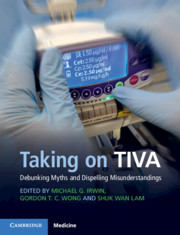Book contents
- Taking on TIVA
- Taking on TIVA
- Copyright page
- Contents
- Contributors
- Foreword
- Power to the People: the Rationale of a Practical Text
- Chapter 1 Why Bother?
- Chapter 2 You Say ‘PK’ and I Say ‘No Way!’; You Say ‘Keo’ and I Say ‘Time to Go!’
- Chapter 3 TCI and TIVA: What a Good Idea!
- Chapter 4 Milk of Amnesia
- Chapter 5 A Catwalk with a Difference
- Chapter 6 Let’s Get Started
- Chapter 7 Let’s Get Pumped!
- Chapter 8 ‘But I’m Used to MAC!’
- Chapter 9 Be Aware, Unaware and Confusion Everywhere
- Chapter 10 Do You Want Fries with That?
- Chapter 11 Intra- and Post-operative Analgesia for TIVA
- Chapter 12 Wakey Wakey!
- Chapter 13 Under Pressure
- Chapter 14 Ankle Biters
- Chapter 15 Old Timers
- Chapter 16 Big Can Be Beautiful!
- Chapter 17 A Bun in the Oven
- Chapter 18 Saving the Whales by Taking on TIVA
- Chapter 19 TIVA Drugs for Sedation
- Chapter 20 Skiing Off-Piste and Other Assorted Goodies
- Index
- References
Chapter 7 - Let’s Get Pumped!
The Nitty Gritty of TIVA Syringe Pumps
Published online by Cambridge University Press: 18 November 2019
- Taking on TIVA
- Taking on TIVA
- Copyright page
- Contents
- Contributors
- Foreword
- Power to the People: the Rationale of a Practical Text
- Chapter 1 Why Bother?
- Chapter 2 You Say ‘PK’ and I Say ‘No Way!’; You Say ‘Keo’ and I Say ‘Time to Go!’
- Chapter 3 TCI and TIVA: What a Good Idea!
- Chapter 4 Milk of Amnesia
- Chapter 5 A Catwalk with a Difference
- Chapter 6 Let’s Get Started
- Chapter 7 Let’s Get Pumped!
- Chapter 8 ‘But I’m Used to MAC!’
- Chapter 9 Be Aware, Unaware and Confusion Everywhere
- Chapter 10 Do You Want Fries with That?
- Chapter 11 Intra- and Post-operative Analgesia for TIVA
- Chapter 12 Wakey Wakey!
- Chapter 13 Under Pressure
- Chapter 14 Ankle Biters
- Chapter 15 Old Timers
- Chapter 16 Big Can Be Beautiful!
- Chapter 17 A Bun in the Oven
- Chapter 18 Saving the Whales by Taking on TIVA
- Chapter 19 TIVA Drugs for Sedation
- Chapter 20 Skiing Off-Piste and Other Assorted Goodies
- Index
- References
Summary
This chapter will set out to describe the mechanical, electronic and programmed mechanisms of the pumps used for TIVA, from the first early prototypes to current build. Mention will be made of algorithms and of different patient populations in relation to these topics and to aspects of the safe delivery of TIVA, again in relation to the pumps themselves rather than the technique as a whole.
- Type
- Chapter
- Information
- Taking on TIVADebunking Myths and Dispelling Misunderstandings, pp. 46 - 51Publisher: Cambridge University PressPrint publication year: 2019



